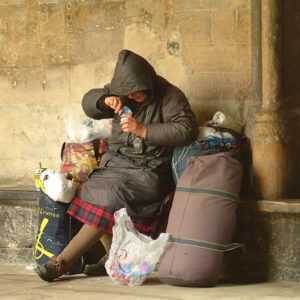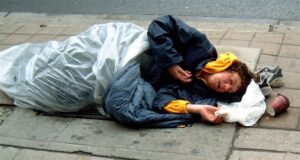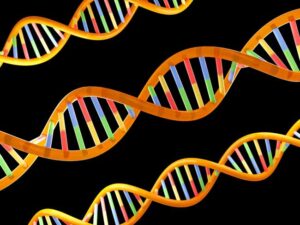Robert Guzman, Sirron Kyles
Understanding Homeless
 Homelessness in the United States is a critical issue that requires everyone’s attention. Hundreds of thousands of Americans live on the streets or in shelters. It is estimated that there are between 900,000 and 2,000,000 homeless individuals in America on any giving night , and that between 3.5 million and 5.5 million Americans will experience being homeless during any given year. Over a five year period approximate 2 to 3 percent of the U.S. population, or 8 million people will be homeless for at least one night during any given year and about 10 percent of these will remain homeless (Harvard Mental Health Letter). Homelessness results from a number of factors some of which include an inability to pay for housing, loss of employment, and domestic violence. For many people being homeless may last a few days and for some a lifetime, some children are born into it, while others experience it at least once during their lifetime (Noll & Watkins).
Homelessness in the United States is a critical issue that requires everyone’s attention. Hundreds of thousands of Americans live on the streets or in shelters. It is estimated that there are between 900,000 and 2,000,000 homeless individuals in America on any giving night , and that between 3.5 million and 5.5 million Americans will experience being homeless during any given year. Over a five year period approximate 2 to 3 percent of the U.S. population, or 8 million people will be homeless for at least one night during any given year and about 10 percent of these will remain homeless (Harvard Mental Health Letter). Homelessness results from a number of factors some of which include an inability to pay for housing, loss of employment, and domestic violence. For many people being homeless may last a few days and for some a lifetime, some children are born into it, while others experience it at least once during their lifetime (Noll & Watkins).
Historically, homelessness has always been a problem in American society. Homeless people were known as “the wondering poor,” “sturdy beggars,” and as “vagrants”, but it was not until the late eighteenth century that homelessness became noticeable to society (Kusmer). According to the National Law Center on Homelessness & Poverty, homelessness has been an enduring problem in the U.S. since the great depression, and has become more prevalent and diverse since the 1980’s. Lack of affordable housing has been cited as one of the major contributors to the problem of people being homeless. Housing is a scarce and important commodity; people without homes are more susceptible to illnesses and death as a consequence of living on the streets (O’Connell).
Homeless people also have an average income of less than half as their domiciled households and can be considered the poorest of the poor (Anderson et al. as cited in Craig and Timms), and “[g]iven the evidence linking homelessness to poverty and social disadvantage, it is hardly surprising that homeless people report higher rates of psychiatric disorder relative to the general population” (Craig & Timms). Researchers have found that a relationship exist between substance abuse and homelessness. Alcohol and drug use are “disproportionately” high among the homeless, addiction also increases the possibilities of displacement (National Coalition for the Homeless).
Homeless people have higher risk of death than the general population and also face many medical problems, such as diabetes, chronic diseases, arthritis, pulmonary diseases to mention a few, all which require attention, but many times such health conditions go untreated because of the lack of resources.
Homeless people face barriers when accessing health care, primarily because of a lack of insurance (Hwang).
The issue of domestic violence is also prevalent among the homeless, especially against single mothers with children, which is considered the fastest growing homeless population (Davis) due in part because nearly 4.4 million women are physically abused (Tower). There are of course other factors that enhance the chances of becoming homeless. These factors include education, race and employment.
It is important to raise community awareness about the effects of homelessness and the factors that contribute to it because it is a prevalent and serious issue in America society. Three important issues need to be highlighted when trying to increase community awareness about homelessness. First, the community needs to know who the homeless population is. Second, an understanding needs to exist of the causes of homeless, and finally why the community needs to become aware of issues dealing with homelessness. The homeless population can be defined as having a “lack [of] a fixed, regular, and adequate night-time residence and…Has a primary night time residency” (Hersberger).
There are a variety of factors that causes homelessness. People become homeless when they lose their homes, their family disintegrates, or due to a natural disaster, etc. (Davis). Because of factors like these there is a need for the community to become involved in decreasing homelessness, but this requires that the community become aware that the issue exist. Awareness may result in the community taking an active stand to combat homelessness. Toro and Warren suggest that awareness brings about participation and the establishment of education, job training, emergency shelters, and soup kitchens, which are beneficial for the homeless.
In order to have community awareness, one must be able to understand what homelessness is all about. There are three issues that can help in explaining the issue of homelessness and thus bring about community awareness. The first issue of importance is to understand who the homeless are and second how and why they have become homeless and finally understanding why it is that the community needs to become aware of homelessness. Many of these issues will be discussed in the following pages.

Who are the homeless?
At the beginning of the decade the stereotypical homeless person was portrayed as a middle aged, White alcoholic male, from an urban neighborhood who wandered the country as a vagrant, tramp or hobo, who lived in isolated downtown areas known as skid rows (Hombs). In order to understand who the homeless are there is a need for a clear definition. Hombs explains that there is no single definition of homelessness and thus provides several definitions. For example in one definition hombs explains that a homeless person is “anyone who lacks adequate shelter, resources, and community ties” (pg. 3). Another definition of homeless offered by Hombs is one form the national coalition for the homeless:
“Homeless means more than not having a place to sleep. Being homeless means having no place to save the things that connect you to your past, losing all contact with friend and family, and uprooting your children from school. It means suffering the frustration and degradation of living hand to mouth, depending on generosity of strangers or efficiency of a government agency for your survival, for your children’s survival.”(Hombs).
In order to understand who the homeless are there is a need for a clear definition, but a clear definition can be hard to explain. For example, Toro and Warren explained two major points of contention in defining homelessness. First is the issue of what constitutes living arrangements. Second, what length of time must one live in such arrangements to constitute homelessness, does living on the streets or in a shelter constitute a living arrangement and what is the length of time one must live in such living arrangements? Does sleeping in a shelter one night constitute homelessness, or does sleeping 3 nights or 30 nights? As aforementioned homelessness can be difficult to define.
However, one definition worth stating comes to mind. “Homelessness is a condition of detachment from society characterized by the absence or attenuation of the affiliate bonds that link settled person to a network of interconnected social structures” (Caplow, Bahr, and Stenberg, As cited in Glasser). The condition of detachment can be explained as an insecure attachment experience in which a person will develop a working model for constructing a negative world of himself and the world around him or her (Tavecchio & Thomeer).
The other important word worth defining is the establishing of social bonds which can be explained in terms of ones social networks. Homeless people establish social networks with one another to generate social capital resources and protection from physical harm, but have limited contact with family members or parents (McCarthy, Hagan, & Martin). Many homeless individuals lack positive social networks required to avoid being homeless. For example many women become homeless when their marriage breaks up, thus, they must find a different place to stay or for that matter a shelter were her social network is confined to other homeless women in the shelter (Michell as cited in Glasser).
People who are homeless can be categorized as chronic, deinstitutionalized or temporary homeless. The chronic homeless are more or less persons who are permanently homeless without a fixed home, and the most visible of the homeless population in the streets and shelters (Fantasia & Isserman). Deinstitutionalization can be explained as the discharging of previously and long term “hospitalized patients” and the current brief stay of psychiatric patients; it can be viewed as a revolving door of health care and the implementation of policies that make admissions of the mentally ill more difficult (Glasser; Glasser8; Bachrach). “This phenomenon is viewed as one of the major factors contributing to the large number of homeless in the United States (Evans & Forsyth). The temporarily homeless are characterized as those who have set backs but who can rely on family or friends to take them in or lend them money after an eviction or a night on the street, and who are able to move off the streets in a short time and regain control of their lives (Davis).
How do they become homeless?
The homeless population can be separated into three categories: The chronic homeless, the deinstitutionalized, and the temporary homeless. An exploration of the most important issues in each category will be explained and how such issues bring light on how people become homeless. The chronic homeless are considered to be the most visible of the homeless population (Fantasia & Isserman). Chronic homeless is usually a chapter which begins during ones childhood (Harvard Mental Health Letter), and goes on for years. Chronic homelessness has been associated with issues of drugs and alcohol use, and is usually prevalent among early adulthood homeless (O’Toole et al.
As stated earlier deinstitutionalization can be explained as the discharging of previously and long term “hospitalized patients” and the current brief stay of psychiatric patients (Glasser). According to Hodulik; deinstitutionalization is where the large percentage of mentally ill homeless comes from. Prisoners also face homelessness once released from jail, due in part to the difficulties they face in finding a place to stay and stable employment (Kushel). People become homeless as a result of the discharge from military or who were in service in past years.
The issue of homeless veterans is very serious “VA estimates that nearly 200,000 veterans are homeless on any given night. And more than half a million experience homelessness over the course of a year” (National Coalition for Homeless Veterans). The same source states that many of the veterans have served in World War II, Korean War, Cold War, Vietnam, Grenada, Panama, and the Gulf War. The issue of Deinstitutionalization can be viewed as a revolving door for veterans, because when previously homeless attend a health facility, and are then released with no place to go (Glasser). For example, in a study of veterans who were hospitalized for mental illness it was found that about 18 percent were homeless at the time of admission (Folsom et al.), which means that most likely they will have no place to go.
The temporary homeless includes people who are able to move off the streets within a short period of time and are able to regain control of their lives (Davis). Temporary homeless also include those who lack social and monetary resources, and who can rely on the goodwill of friends or family members to provide shelter (Rog & Buckner). Many are homeless due to a natural disaster, which makes their homes uninhabitable such as, flood, fire, earthquake (Davis)
.
Two other perspectives can also help us underline the issue of homelessness. On the one part you have the industrialized world and on the other you have the developing world. Homelessness in the industrial world is explained in terms of a lack of affordable housing, family disintegration, and drug and alcohol abuse, deinstitutionalization of the mentally ill. In the developing world homelessness was due in part by the explanation of urban and rural migration, severe unemployment, and large number of refugees and also victims of natural disasters (GlasserHowever this topic is too broad and it is beyond the scope of this paper to examine, but it is mentioned as an alternative explanation of why people become homeless.
Historical Perspectives
The issue of homelessness is not new to the US and can be traced back to the years when America was established. During the colonial period the effects of war were the main cause of homelessness. In the 1640’s “vagrant persons” were among the social outcast, but it was not until 1675 that there was an upsurge in the number of vagrancy in New England (Kusmer). Other issues that provoked a surge in homelessness were the French and India wars and the American Revolution of the 1756. The surge among the working class was also evident among indentured servants. In 1770 the majority of people sentenced in Philadelphia were run away servants, former slaves, escaped slaves as well as apprentices who had left their masters.
During the transitional period after the abolishment of slavery newly freed slaves in the north were disproportionately represented among the homeless. From 1823 to 1826 African American comprised 40 to 50 percent of all those in prison for vagrancy, and accounted for one-tenth of the general population. During this period vagrancy was identify with immigrants, particularly the Irish who in many cities comprised the majority of the homeless population. During the 1820’s authorities were assisted in their efforts with the passage of new vagrancy laws which punished beggars harshly.
In later years from 1850 to 1860 there were many unemployed workers, other peoples lives changed due the war, plagues or natural disasters, many others were just adventurers who wandered around. During the 1870’s hundreds of thousands of people wandered from place to place looking for employment, public assistance or any type of handout. Most of the homeless were unmarried young men their social disruption came about due to the war, a large amount of migration form Europe, and the economic depression of 1873, forced people to take life on the road (Fantasia & Isserma).
During a temporary economic boom at the end of the 1870’s some of the “tramps” or wandering men found permanent jobs and housing bringing about neighborhoods with a rapid growth around many cities, such as the Bowery District in New York. These types of neighborhoods were devoted to housing and providing services to these types of people. Neighborhoods such as this were composed as flophouses, pawnshops, cheap restaurants, used clothing stores and religious missions.
Areas such as these were known as “skid rows”, a name derived from the 19th century waterfront district of Seattle Washington, where timber was skidded down the river into the sawmills (Fantasia & Isserma). In the 1880’s the United States was in a moral panic which became know as the “tramp scare” or “tramp evil” because many lost their jobs and were displaced due to economic downturns, many of these men took to the road in search of better opportunities of work.
The “tramp scare” reached its peak from the 1880’s to 1890’s. Tramps were seen as pests and diseased. The word tramp was formulated in 1870 in America to describe the homeless or those who were moving constantly. Cresswell states that raw material, the increase economic downturns, and the national rail system were necessary in the creation of the tramp, which provided the motivation for mobility.
American Great depression
The onset of the American Great depression was an event that resulted in many people becoming homeless. The stock market crash of 1929 known as the worst economic issue to face America during that period brought about a surge in homelessness. Millions of Americans lost everything they owned; by 1933 one quarter of the workforce in America was unemployed. In 1932 sixty cities revealed that assistance, mostly through private charity was sheltering about 400,000 homeless (Fantasia & Isserma).
During this time the vast majority of homeless were sailors. In fact the first shelter was established in New York in 1933 which was thought to be a sailor’s shelter. During this time sources claimed that there were also about 30,000 women who were also homeless (Kustmer).
The word “homeless” became very well known in the 1980’s when a large increase of women, men and children became visible in the streets across the United States seeking a shelter or a place to sleep. For example in Los Angeles the homeless shelter capacity increased by three times between 1986 to 1996 from 3,495 to 10,800 beds. In Boston there was an increase of bed capacity of 246 percent between 1983 and 1995 and in Minnesota homeless shelters quadruple between 1985 and 1997 (Polakow & Guillean).
Wright and colleagues explained the issue of increase homelessness in the 1980’s as an emergent and significant social problem. Homelessness became an issue of discussion among mass media, scholars and policymakers and the public in general. To reinforce the statement above Burt and Cohenstate that in 1987 there were 194,000 homeless adults using soup kitchens and shelters. Due to much public interest in homelessness, congress introduced thirty-two separate bills addressing issues of homelessness, and considered a similar number in 1986
During the 1990’s homelessness was viewed as an issue which elicited apathy and anger in the general public. In New York for example, punitive tactics were brought about when dealing with the homeless. Mayor Rudolph Guiliani led the passage of the “quality-of-life” ordinance which allowed law enforcement officers to arrest any homeless person for any trivial misdemeanor, such as sleeping in the streets or sitting on sidewalks, by the end of the 90’s the National Law Center on Homeless reported that about 75 percent of 49 cities surveyed had such laws in their books (Kusmer). “In 1996 Urban Institute Survey estimate that in an average night 470,000 persons in the United States were sleeping in shelters, but a much larger number, close to 2 million, had experience homelessness at some point during the previous year” (Kusmer).
In the year 2008 millions of Americans lost their jobs, and many had increased economic insecurities. Hard times like this placed many demands on emergency social services, by 2009 over 25,000 people were sleeping in New York City shelters every night, and over 600,000 New Yorkers were using public shelters and soup kitchens every month. Public shelters in major cities across the United States faced overcrowding (Marcus).
Housing
During the past two decades before 2010 there has been an unprecedented increase in homelessness.
The lack of affordable housing and poverty has been one of the leading causes of homelessness (Duffield). Housing is viewed as an important solution in dealing with the homeless.
Since the mid-eighties the federal government has implemented national policy and new federal legislation to deal with the issue of homelessness which was seen as a national crisis, but regardless of government legislation about 12.5 million households are at risk of becoming homeless because of the high cost of housing and low paying jobs. In other words, there is not sufficient housing to accommodate those in need. For example in 2003 there was an 83 percent increase in requests for housing assistance, of the twenty-six US cities surveyed, 48 percent stopped accepting new applications (National Law Center on homelessness & Poverty).
In 1998 the Department of Housing and Urban Development reported that 5.3 million households were unable to find affordable housing, of these households one-seventh including 4.5 million children lived on less than 50 percent of the median income (Markos & Lima).According to the institute of children and poverty) “[b]etween 1997 and 2000 rents nationwide increased [by] 14%, which is a rate 30% higher than the overall inflation” (p. 2). The average wait for applicants applying for public assistance is 20 months, and for those hoping to acquire section 8 vouchers, which allows an individual to rent public housing at reduced prices in the open market, can expect to wait longer. In some places the wait is up to 84 month such is the case in parts of New Jersey, or 60 months in Miami (Clarke).
Lack of affordable housing can cause vulnerability to diseases and illness associated with malnutrition or inadequate health care which can result in homelessness. Another important issue to consider is the amount of earned income that goes to paying for a place to stay. For example Freeman explains that “in 1989, 17% of renters paid more than 50% of their income for rent” (p. 710). The federal government does provide housing assistance for about 4.6 million households, however roughly 9.7 million low-income people receive no housing assistance).
Poverty
It should be no surprise that the lack of income is a significant contributing factor to homelessness. As aforementioned two trends are largely responsible for the increase in homelessness. First, the lack of affordable housing and second, the increased in poverty, it is obvious that people in poverty have a hard time or face challenges when paying for food, clothing, health care, child care and education. Over the years the number of poor people has increased in the U.S. In 2003 35.9 million people lived in poverty (National Coalition for the Homeless).
While many factors contribute to the increase in homelessness, two factors contribute to the increase in poverty, lack of work opportunities and a lack of public assistance. In a study of 777 homeless parents across 10 U.S. cities were surveyed, 78 percent of those were single mothers, while 19 percent were two parent families. The vast majority of those surveyed stated that a lack of child care and pregnancy were the two main reasons for their inability to find employment. Lack of child care or children being too young are cited as the main reason for unemployment in 7 out of 10 cities (Nunez & Fox).
Because of a lack of public assistance many low income house-holds and homeless people go hungry. In a study of 354 homeless women with children was conducted to understand whether respondents or their children had experienced hunger during that past year, it was found that 38 percent had a primarily adult hunger and 17 percent had both adult and child hunger (Wehler, Weinreb, Fletcher, Goldberg, Hungtinton, Scott, Hosmer, & Gunderson).
Mental illness
Mental ill homeless “represents one of the most vulnerable and disadvantaged segments of the society” (Folsom, Hawthorn, Lindamer, Gilmer, Bailey, Golshan, Garcia, Unutzer, Hough, & Jeste). Approximate four percent of the US population suffers from mental illness and about 20 to 25 percent of the homeless population suffers from some form of serious mental illness. The diagnoses include chronic depression, bipolar disorder, schizoaffective disorders and severe personality disorders (National Resources and Training Center on Homelessness and Mental Illness). Affective disorder can be characterized as “pertaining to feelings and emotions” (Okun). Wong) states that in previous years the homeless adult population documented as much as three quarters of diagnosable mental illnesses. The same author states that recently empirical evidence places this figure at one third of the homeless population as suffering form severe mental illness. Some of the homeless have had a life time diagnoses of mental illness. For example, in one study of 445 homeless it was found that 51 percent had a life time diagnoses of DSM-IV Axis 1 disorder.
The most common among these types of disorders was the affective disorder (Caton, Dominguez, Schanzer, Hasin, Shrout, Felix, McQuistion, Opler, and Hsu). In a study of 430 respondents of 18 years and older who had reside either in a shelter or some type of agency which provided meals to people in poverty, in order to qualify for this study individuals had to have stayed in an unconventional accommodation such as a temporary shelter, the streets, hotel or motel paid by vouchers, or in abandoned buildings, within the 30 days proceeding the interview of the study.
Of the 430 respondents about 20 percent had current diagnoses of severe mental illness and 77 percent had a major affective disorder. The majority 58 percent were diagnosed with schizophrenia and also a major affective disorder (Wong). In another study of 10,340 persons with mental illness, which was design to examine the prevalence and risk factors of treating the mentally ill over a one years period (1999-2000) it was found that the prevalence of homeless was 15 percent, from those, 20 percent suffer schizophrenia, 17 percent bipolar disorder and 9 percent depression (Folsom et al).
Substance Abuse
Substance abuse is another important subject pertinent to homelessness. As mentioned earlier, homeless people use health care at a very high rate. However, much of this high rate has to do with substance abuse. Substance abuse is also linked with loss of housing and breakdown of social bonds. Substance use is extremely prevalent among the homeless population and it can be a major precipitant of homelessness (O’Toole, Gibbon, Hanusa, Freyder, Conde, & Fine). In a study by Kushel, Hann, Evans, Bangsberg, & Moss of 1325 homeless participant it was found that 60 percent reported using illegal drugs at least once over the past year, 50 percent of the participants reported using Crack cocaine, and 84.4 percent reported using some type of drug during their life time.
To support the relationship that exists between life time use of drugs and homelessness Caton et al., study of 445 homeless people found that 53 percent of participants had a lifetime diagnosis of substance use disorder, the most commonly used substances were cannabis, cocaine and alcohol, and 44 percent had received treatment for substance abuse. In another study of 531 adult homeless people from two major cities (Pittsburgh and Philadelphia) were interview to assess their substance use.
Overall, 78.3 percent of respondents met DSM-III-R criteria for substance abuse or for dependence of alcohol, drugs, or a combination of alcohol and drugs. Chen, Tyler, Whitbeck, and Hoytstudy of 356 female homeless and runaway adolescent found that 64.9 percent used marijuana, 22.4 percent used amphetamines and about 19.6 percent used hallucinogens during the last year.
Alcoholism among homeless is very prevalent, In fact about 40 percent of homeless have problems with alcohol, and several studies demonstrate that homelessness and alcohol use go hand to hand. For example, in a study of 1325 homeless participants about one quarter or 23.9 percent reported having problems with alcohol during the last year, while 44 percent reported having alcohol problems during their lifetime (Kushel et al.,).
In a study of 186 homeless and runaway youth in Denver Colorado using a self administered questionnaire from the Treatment Episode Data Set (TEDS), it was found that in the past 9 month of the date of the study 75 percent had used marijuana, 69 percent used alcohol, 30 percent used hallucinogen and 25 percent used ecstasy (Leeuwen, Hopfer, Hooks, white, Perertson, & Pirkopfm,).
Health care
The number of Americans who do not have health care continues to rise. In the year 2003 there were about 15.3 percent or 43.6 million Americans without health insurance and the number grew in 200 to 44 million (U.S. census, 2004). Homeless individuals have a high rate of health care use and are admitted to hospitals up to 5 times more that the general population. Homeless people suffer from a wide variety of medical issues. Homeless people in their 40’s or 50’s can develop diseases that are commonly seen in much older adults. Homeless who live on the streets have higher health issues than homeless who live in shelters. The most prevalent health issues facing the homeless population range from seizures, arthritis, chronic obstructive pulmonary disease, hypertension, diabetes and respiratory tract infections, oral and dental health is also commonly poor among the homeless (Hwang,).
These illnesses in conjunction with inadequate health care, and poverty lead to high mortality rates among the homeless population. For example in Philadelphia the mortality rate for homeless adults was 3.5 times higher than the general population, and in a study of homeless using shelters in New York found that death rates of homeless were 2 to 3 times higher than that of the city’s general population (Cheung & Hwang). It is important to mention that homeless children face higher rates of health related problems when compared to children who have homes. In a study of 293 homeless and 334 low-income housed children between the ages of 3 months old to 17 years old, it was found that homeless children were more likely to report poor health that their housed counterparts (Weinreb et al.,).
Domestic Violence
It is estimated that about 60 percent of mothers have experience some form of domestic violence in their lives, making the connection between homelessness and domestic violence undeniable (Homes for the Homeless). In fact “domestic violence was named as the primary cause of homelessness in nine out of the twenty cities surveyed by the U.S. Conference of Mayors in 2003” (National Law Center on Homelessness & Poverty), about one in four mothers reported been homeless as a result of leaving their home to escape domestic violence and almost half of school age children who are homeless reported witnessing domestic violence). Many adolescents are also victims of abuse.
For example in a study of 361 female homeless and runaway adolescent it was found that 32 percent reported been sexually abused by an adult caretaker and about 23.7 percent reported that at some time a parent or caretaker requested sex, and about 22 percent of these youth reported been forced to have sexual intercourse (Chen, Tyler, Whitbeck & Hoyt). Domestic violence definitely plays a role in homelessness, due in part to the high increase in victimization of youth. It is estimated that 25 percent of girls and 10 percent of boys suffer some type of victimization before the age of 18 (Finkelhor, 1993 as cited in Chen et al., 2004). In fact, adolescents rank sexual abuse as the most important reason for running away from home (Chen et al.).
Other factors
There are other additional factors that increase the chances for people becoming homeless. These include educational, employment and race. All three factors contribute in one way or another to people becoming homeless, sometimes one individual factor is enough for one to become homeless, in other cases all factors are directly and indirectly tie to homelessness.
Education
Education traditionally has been regarded as a tool for social mobility. The homeless population however seems to be deprived of the benefits of school, especially young children, mainly because of their constant mobility to shelters, hotels or the constant movement on the streets (Fantasia & Isserma). Homelessness severely affects the health of children, especially issues of physical and mental problems which clearly impact the children’s ability to attend school. In addition to this, homeless students face problems with school attendance, residency requirements, lack of school supplies and a lack of transportation.
About 45 percent of homeless children do not attend school on a regular basis and 12 percent of school-aged homeless children are not enrolled in school while being homeless (Duffield). Children who are homeless, poverty stricken experience higher levels of learning disabilities than other children (Markos & Lima). Homeless student are also at a disadvantage when doing school work, mainly due to a lack of access to computers, libraries, and class materials (Vissing).
Employment
Homeless people face many barriers when seeking to gain employment; such barriers include a lack of child care, pregnancy, transportation, lack of permanent address, etc. In the United States about 79 percent of homeless parents are unemployed, and nearly 4 percent of homeless individuals have never worked, and about 12 percent have been unemployed for more than two years (Nunez & Fox). For those few that can work, jobs are usually part-time with low wages and no benefits, which leave little resources to pay rent, bills and essentials for the family (The Institute for Children and Family).
Race
In a study of homeless families African Americans were heavily over represented in the homeless population. Nationwide over 58 percent of homeless families are African American, followed by Whites who compose 22 percent of homeless families and finally Latinos who compose 22 percent of homeless families. The greatest proportion of African American homeless are in the Southern, Midwestern and Eastern cities, Latinos are the New York and southwest, and the highest proportion for whites is in the Northeast and smaller cities (Ralph & Cybelle, 1999).
In a study of 370,000 residents who had experience homelessness within the previous 5 years of the study in Los Angeles California during the spring and summer of 1997, it was found that while all ethnic and racial groups were prominent for becoming homeless, it was found that Latinos, Whites and African Americans represented the largest homeless population during this time. Latinos for example represented 43 percent; whites comprise 35 percent and African Americans 17 percent (Cousineau).
Facts on Who Are Homeless
The deinstitutionalized homeless are those who are released from hospital, prison with no place to go (Davis).
About 12.5 million households risk the possibility of becoming homeless because of the high cost of housing and very low paying jobs (National Law Center on homelessness & Poverty).
Many people leave their homes voluntarily or forcefully, for example, battered women, and runaway teens, (Davis).
Many people are homeless because of a natural disaster, which makes their homes uninhabitable for a long period of time (Davis).
Homeless who experience sexual abuse have higher rates of substance abuse (Chen et al.).
About 40 percent of homeless work part or full time during any given month according to the National Law Center on homelessness & Poverty.
Homeless people have a greatly increase risk of death (Hwang).
Children who are homeless on any given night ranges from 61,500 to 500,000 (Davey).
The majority of homeless populations are people of color (North & Smith).
Approximate 2 to 3 million people experience an episode of homelessness during a given year (Caton, et a.).
Single women with children represent one of the most rapidly growing groups of the homeless population (Zugazaga).
Facts on Why People Become Homeless
People who are released from hospital, prison, residential institution or leave the armed forces and have not place to live (Davis).
About 12.5 million households risk the possibility of becoming homeless because of the high cost of housing and very low paying jobs (National Law Center on homelessness & Poverty).
Many people leave their homes voluntarily or forcefully. For example, battered women, runaway teens (Davis).
Between 1997 and 2010 rents increase 14 percent nationwide (Institute for Children and Poverty).
There is not enough emergency shelter to meet the need (National Law Center on Homelessness & Poverty).
In 2004, 17 percent of people renting a home paid more than 50 percent of their income to rent, in 2008, 20 percent did (Freeman).
Homelessness is the manifestation of lack housing and poverty (Duffield).
About 30 Percent of homeless have a form of mental illness (Davis).
Children who are homeless on any given night ranges from 61,500 to 500,000 (Davey).
About 12.5 million households are at risk of becoming homeless due to high housing cost and low-paying jobs (National Law Center on Homelessness & poverty).
About 30 percent of homeless are substance abusers (Davis).
Lack of care from a parent during a childhood increases the chances and likelihood of homelessness (Herman et a.).
Facts on Community Awareness
Most people confronted with homelessness, reach with a wanting to help (Foscarinis).
Providing supportive services to people in housing has proven to be good and affective in achieving residential stability and improving mental health (National Resources and training Center on Homelessness and Mental illness.
Polls found that 60 percent of those surveyed indicated a willingness to pay more taxes to help people who are homeless (Toro & Warren).
Many people see homelessness as a gross social injustice, and a good number volunteer, donate goods, contribute money, and some offer their professional services (Foscarinis).
A national surveyed found that 65 percent of Americans are willing to pay and extra more in taxes to help homeless people (Toro and Warren).
Integrated mental health and substance abuse treatment deliver by multidisciplinary mobile treatment can reduce symptomalogy and improve functioning of the community (National Resources and training Center on Homelessness and Mental illness).
Ending homelessness will required closing the gap between housing cost and earned income (National Coalition for the homeless).
The implementation of fundamental principles of human rights is critical (National Law Center on homelessness & poverty).
To prevent homelessness there must be enough low-income housing, income support, low health care services (National Coalition for the homeless, 2010).
 If you’re going to take a long-term car loan, don’t buy a short-term car. — Spencer Johnson, Kenneth Blanchard
If you’re going to take a long-term car loan, don’t buy a short-term car. — Spencer Johnson, Kenneth Blanchard


 To “let go” does not mean to stop caring, it means I can’t do it for someone else.
To “let go” does not mean to stop caring, it means I can’t do it for someone else.

 Homelessness in the United States is a critical issue that requires everyone’s attention. Hundreds of thousands of Americans live on the streets or in shelters. It is estimated that there are between 900,000 and 2,000,000 homeless individuals in America on any giving night , and that between 3.5 million and 5.5 million Americans will experience being homeless during any given year. Over a five year period approximate 2 to 3 percent of the U.S. population, or 8 million people will be homeless for at least one night during any given year and about 10 percent of these will remain homeless (Harvard Mental Health Letter). Homelessness results from a number of factors some of which include an inability to pay for housing, loss of employment, and domestic violence. For many people being homeless may last a few days and for some a lifetime, some children are born into it, while others experience it at least once during their lifetime (Noll & Watkins).
Homelessness in the United States is a critical issue that requires everyone’s attention. Hundreds of thousands of Americans live on the streets or in shelters. It is estimated that there are between 900,000 and 2,000,000 homeless individuals in America on any giving night , and that between 3.5 million and 5.5 million Americans will experience being homeless during any given year. Over a five year period approximate 2 to 3 percent of the U.S. population, or 8 million people will be homeless for at least one night during any given year and about 10 percent of these will remain homeless (Harvard Mental Health Letter). Homelessness results from a number of factors some of which include an inability to pay for housing, loss of employment, and domestic violence. For many people being homeless may last a few days and for some a lifetime, some children are born into it, while others experience it at least once during their lifetime (Noll & Watkins).
 A buffalo soldier was an African-American serving in one of the U.S. Army’s African-American regiments. The term buffalo soldier is derived from an Indian term that described the perceived resemblance between the soldiers’ hair and a buffalo’s head hair. It is unclear whether the term originated in the Cheyenne, Apache, or Kiowa tribe. It is still a matter of contention whether the Indians meant respect or disrespect by using this term.
A buffalo soldier was an African-American serving in one of the U.S. Army’s African-American regiments. The term buffalo soldier is derived from an Indian term that described the perceived resemblance between the soldiers’ hair and a buffalo’s head hair. It is unclear whether the term originated in the Cheyenne, Apache, or Kiowa tribe. It is still a matter of contention whether the Indians meant respect or disrespect by using this term.
